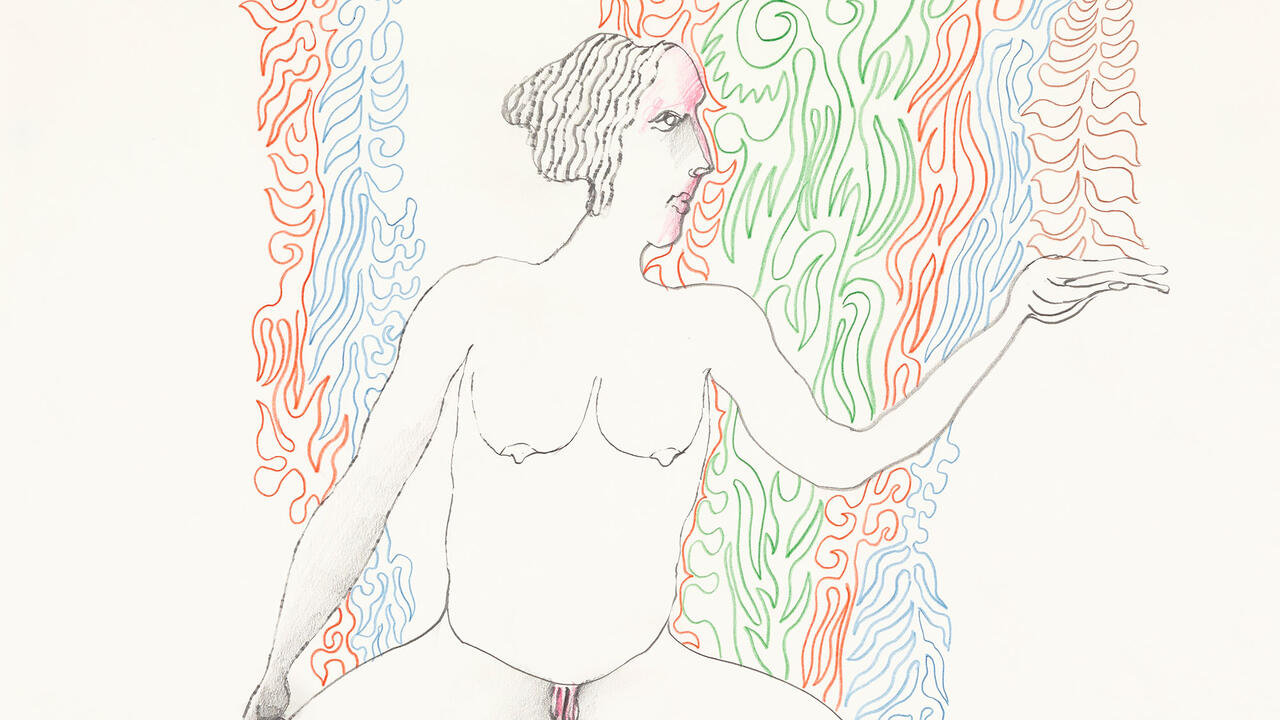Martha Jungwirth’s Energetic Abstractions
At Thaddaeus Ropac, Paris, the Austrian artist mines epochs of ancient history to bring painting back to a time before consciousness
At Thaddaeus Ropac, Paris, the Austrian artist mines epochs of ancient history to bring painting back to a time before consciousness

Martha Jungwirth’s current exhibition at Thaddaeus Ropac – her first with the gallery – comprises 24 paintings in quick, gestural brushwork that present enigmatic scenes of human and animal forms in motion, faintly reminiscent of the prehistoric cave paintings at Altamira or Lascaux. Adhering mostly to a limited palette of red, yellow, purple and magenta, Jungwirth veers from this to dramatic effect in certain pieces. The central form of Die Kröte (The Toad, all works 2021), for instance, a small painting on cardboard, is bright green; its unexpected colour jumps out. Similarly, in Memorial I (Triptychon) – one of four large-scale oil paintings on paper – the startling effect of a sudden stroke of bright orange between two of the three panels suggests the movement of one figure towards another across the picture plane for some inscrutable purpose.

Many of the titles in the exhibition reflect Jungwirth’s longstanding engagement with Ancient Greece. These range from architectural terms, such as a series of works titled ‘Metope’, to a piece named after Alexander the Great’s legendary horse, Bukphalos (Bucephalus). The artist’s interest in the ancient world corresponds with her career-spanning desire to take art back to direct experience, or what she calls, in a video on the gallery website, ‘the energy of painting’. In Roberto Calasso’s 2019 The Celestial Hunter, the late critic discussed the point at which ancient Greek myths separated from lived experience as the moment that humans became conscious of our separation from the world. Before this, Calasso claimed, the line between things, humans, the cosmos and animals were ‘never clear cut, always temporary’.
If Calasso’s book traces humanity’s transition towards a rational world, Jungwirth’s oeuvre can be understood as an attempt to reverse that process via painting. She paints to return to a moment before self-consciousness. In her poetic manifesto ‘the ape in me’ (1988), Jungwirth championed a method of painting that privileged instinct: ‘to before spoken language / to before perception / to before memory / to before Euclid where the straight lines meet at the vanish point.’ At Thaddaeus Ropac, this is reflected by the directness of her brushstrokes and her work’s formal similarity to prehistoric art.

Throughout Jungwirth’s practice, however, there runs an intriguing tension between the works’ titles and their almost-abstract figures. Sometimes, the titles refer to the animals whose forms are suggested in the painting; others are more complex. Each work in her ‘Metope’ series, for instance, has one central painterly gesture that resembles a figure, in an echo of the narrative sculptural subjects that adorned the metopes of classical Greek buildings. Here, each painting is a singular image, a static frame that hints at a larger procession. Their presentation indicates sequence but, in every other way, they withhold the story that would tell us what they mean. The series is painted on what appear to be found pieces of cardboard in various states of decay: some have water stains; the edges of others are uneven. Jungwirth’s choice of material intimates that the ruins we will leave behind are less noble than those found in places like the Parthenon. And yet, in that gap between her painterly surfaces and the meaning attributed to them through her titles, Jungwirth uses materials such as old cardboard not only to lament the current state of things but also to repurpose and transform.
'Martha Jungwirth: Recent Paintings' is on view at Thaddaeus Ropac, Paris, until 16 October.
Main image: Martha Jungwirth, Tutanchamun (Triptychon), 2021, oil on paper on canvas, 238 x 900 cm






















